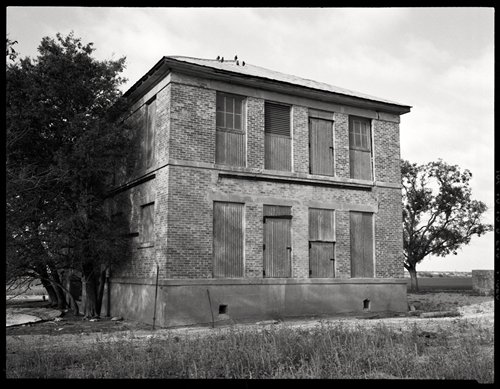Whiteland, Texas, McCulloch County. (original) (raw)

Directions furnished by McCulloch Countian Jim Johnson:
About 7 miles west of Brady on US 87, north of the highway at a "T" intersection of 2 gravel roads there is sign on the highway pointing to the West Sweden cemetery. Three miles west of this point - is the turnoff for West Sweden. The gravel road goes south another 3 miles where you cross on a small bridge over Brady Creek and up around a 90� right turn (west). Before you make the corner to should be able to make out the old railroad bed. Within a � mile drive, you are in the middle of "downtown" Whiteland. The school building is in a field to south. The cotton gin and the loading pens were in the pasture to the north of the county road.
History in a Pecan Shell
Whiteland was named to honor the White family who donated land for the townsite. A post office open the following year and by 1914 the town reported a population of fifty. The prosperity of the 20s boosted the population to 125 by the middle of that decade, but the Great Depression took its toll and by 1943 only 40 people were enumerated. The post closed sometime before the mid-1950s.
Additional History
by Jim Johnson:
"Whiteland is another Texas ghost town to have just about blown away with usually present winds. It is / was located in McCulloch County, about half way between Brady and Melvin. When the railroad continued on westward from Brady, the line branched at Whiteland (also listed on the railroad map as Homer Junction). The earliest line, the Frisco, was built through on it way from Brady to Menard in 1910. In 1911, the Gulf, Colorado and Santa Fe was extended to Melvin and Eden.
The Frisco Railroad came south from Brownwood into Brady in about 1903. When the Santa Fe came from the east, Lometa to San Saba and on, the two lines joined near the East Sweden community and shared trackage from there into Brady and on west to Whiteland (Homer Junction).
Whiteland developed into a small town with live stock shipping pens and a cotton gin on the south side of the railroad. A school, store, and ( I think ) a post office came into being. The 2 story brick school building still stands, lonesome in the middle of a field. As with many of these towns, automobiles and World War II signal their demise. The school was consolidated with the Melvin system. Cotton had replace grain crops and in about 1948 the gin burnt down. Finally the rails were pulled up and Whiteland was pretty much just a memory." - Jim Johnson, October 29, 2006
Our thanks to Jim Johnson for suggesting Whiteland and West Sweden for inclusion in Texas Escapes
Photographer's Note
My father was born in Melvin, Texas on March 3rd 1915. He owned a farm there for many years. He told me many times about the Whiteland school and spoke fondly of it. He used to tell me that he and his brothers would occasionally ride the train which passed by to and from school. The tracks are gone now (I have some great glass insulators from when they removed the track) but I wondered how my father did that...the train must have moved slow! He told me that once he fell from the train and ripped a leather coat my grandparents had given him. His father was quite upset with him. My father passed away in 2005, and I wish he were still around to share his stories about Melvin, Texas. - William Perez, December 06, 2007
Photographer's Note:
The 1940 Texas Highway Map showed an impressive little town at Whiteland. We weren't going any closer through that pasture as the area was crawling with rattlesnakes. - Stephen Taylor, Austin TX, October 28, 2007
Texas Escapes, in its purpose to preserve historic, endangered and vanishing Texas, asks that anyone wishing to share their local history, stories, landmarks and recent or vintage photos, please contact us.
